Introduction
Disasters can happen anytime, anywhere, and sometimes without warning. Your
American Red Cross and your local government agencies will respond when a
disaster threatens and after a disaster strikes. However, they can't be everywhere at once. Being ready for a disaster is a part of maintaining your independence.
Although you may not know when a disaster will strike, if you are prepared
ahead of time, you will be better able to cope with the disaster and recover from it more quickly.
When a disaster occurs, the first priority of disaster relief organizations and government agencies is to provide basic needs-food, water, and safe shelter-to everyone who needs them. Your personal needs, such as replacing medications,
replacing adaptive equipment, restoring electricity for power-dependent
equipment, and restoring your regular ways of support for daily living activities may not happen right away. It is important for everyone to be prepared to meet his or her own basic needs by storing food and water for a minimum of three
days or more. You should also be ready to meet your specific disability-related needs by storing sufficient oxygen, medications, battery power, etc., for at least seven days after a disaster.
Knowing about disaster threats and their aftermath and being prepared are
critical for staying self-sufficient after a disaster. This booklet covers some issues that people with disabilities may face when a disaster strikes. The booklet also has information about how you can get to a safe place and how you can
meet your needs after the disaster.
The best way to cope with a disaster is to learn about the challenges you might face if you could not use your home, office, and personal belongings. You can
meet your basic personal needs by preparing beforehand. You also may have to
deal with a service animal that is unable to work or is frightened, or pets that need care and assistance.
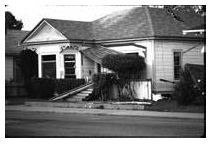
Understanding Disasters
To find the best ways to prepare for a disaster, consider the following questions:
What kinds of disasters may occur in your area?
How are residents informed of possible disasters?
What are the effects of disasters on you and your community?
Contact your local American Red Cross chapter, your city/county emergency
management office, or your local fire department. You can get information
about the kinds of disasters that happen in your
area and how often they occur. Check with your
insurance agent about whether your insurance
policies cover the types of disasters that can
happen where you live. For example, regular
insurance does not cover floods. You must have a
flood insurance policy to cover flood damages.
After a disaster, your environment may be very different. Exits may be blocked, sidewalks may be impassable. If you are prepared ahead of time, you will be
better able to cope with the disaster and recover from it more quickly.
Know the difference between a "watch" and a "warning"
The National Weather Service gives information to the public about some
severe weather events, such as thunderstorms, winter storms, hurricanes, floods, flash floods, and tornadoes. Listen or watch for these terms:
Watch: A "watch" means that severe weather is threatening and may occur in your area. Continue to listen to the radio or watch television for information and advice.
Warning: A "warning" means that the event is happening now; it is imminent or has been seen on weather radar. This is the time to immediately protect
yourself. Some events happen very quickly, so warnings may not be issued or
you may not receive them. Always pay attention to the weather around you.
Take action when you think severe weather maybe moving into your area, even
if no official warning is given on the radio or television.
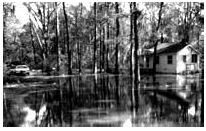
Know what your environment is likely to look like after the disaster
Disasters have many effects. Some are predictable and others are not. You
should know what can happen and what your environment may be like after the
disaster. It is our goal to help you deal with the hardships of a disaster. And you can. But first we must take a realistic look at what can happen during a disaster.
Consider the following circumstances:
In a disaster, roads and sidewalks may be covered
by mud, water, or debris. You may not be able to
tell where roads and sidewalks begin or end.
In disasters that have high winds and during
earthquakes, a great deal of shaking may take place. This can break things and scatter debris. Hanging objects, such as plants, mirrors, and pictures, are likely to fall. Books may be flung from bookcases and the bookcases may fall. In your office, file cabinets, computers, and other unsecured items may fall.
Acoustical ceiling tiles and all of the dust behind them may drop. Large and
heavy furniture, such as couches, chairs, beds, and dressers, may move and
block your pathway completely or in part.
Floods, earthquakes, and winter storms can cause sidewalks and roadways to
crack or become impassable. Roads and sidewalks may be covered by mud,
water, or debris, so you may not be able to tell where they begin and end. Mud, sand, and other materials maybe left behind for long periods. In floods, the
water may be moving very rapidly. This can keep you from leaving an area.
There could be so much debris on the streets that it would take weeks to clear it away. This could leave you stranded at home and keep caregivers from reaching
you.
Familiar landmarks you use to help guide you may move or be destroyed, both
indoors and out. If you have a service animal, such as a guide dog, hearing dog, or personal-care monkey, the animal may be hurt or too frightened to work after a disaster.
Your home may be destroyed or isolated. Or, it could have enough damage to
make it unliveable for a long time.
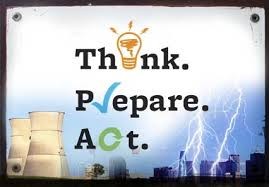
Your usual ways of getting groceries, medications, and medical supplies may be disrupted. It may take several days before stores reopen, so you may not be able to readily replace even basic items related to your disability, like hearing-aid batteries and prescription medications.
You may not be able to carry out your daily activities as you did before the
disaster. You may have a hard time reaching or getting help from police and fire departments, ambulance services, doctors, hospitals, pharmacies, veterinarians, markets, personal assistants, and other home health providers. Utilities like
electricity, water, gas, and phone service may be disrupted for a long time.
You may not be able to do the following:
1. Cook.
2. Cool or heat your home.
3. Make or receive phone calls to or from your doctor, fire department,
ambulance service, support network, and others. You may not be able to
use telephone relay systems and/or teletype equipment because systems
may be overloaded or destroyed.
4. Light your home. You may have to move or communicate in the dark.
5. Receive emergency information from your television or radio.
6. Use equipment dependent on power, such as battery chargers, oxygen,
suction devices, or home dialysis equipment.
7. Access cash through an automatic teller machine (ATM). Also, banks
may be closed.
8. Fill vehicles with gas since pumps may not be working.
Know some other effects of a disaster
Public transportation may not be working. Routes and schedules may be
changed. Public and private wheelchair transport services or Para transits may not be operating.
Roads may be damaged or blocked. Road signs may be down. Traffic lights and
walking signals used to cross the street may not be working properly, or at all.
This can disrupt cues used to cross the street. Travel time may be longer
because of detours and added traffic.
Noisy surroundings, like a shelter, may interfere with how well your hearing aid functions. Also, the vibratory cues you are used to may be disturbed. A noisy
environment can be very disorienting for people with visual impairments, as
well. You may need temporary housing for pets.
Know how disaster-related stress may affect your disability
Experiencing a disaster can be overwhelming. Stress makes many medical
conditions worse. Everyone affected by a disaster may experience one or
several of the following symptoms:
Psychological and Emotional
Anxiety
Irritability, restlessness, over excitability
Depression, moodiness, crying
Anger, blaming
Feelings of apathy, diminished interest in usual activities
Feelings of isolation, detachment, estrangement
Feelings of guilt about surviving
Denial or constriction of feelings
Flashbacks or unwelcome memories of the disaster
An exaggerated reaction to being startled
Recurrent nightmares about the disaster or about other traumatic events
Inability to fall or stay asleep
Sleeping excessively
Thought
Poor concentration
Mental confusion
Slowness of thought
Inability to express yourself verbally or in writing
Forgetfulness
Inability to make judgments and decisions
Loss of ability to think of alternatives or prioritize tasks
Physical
Headaches
Weakness
Nausea, upset stomach, other gastrointestinal problems
Muscle soreness
Hot or cold spells; sweating or chills
Numbness or tingling in body parts
Heavy feeling in arms and/or legs
Feeling a "lump" in your throat
Chest pains
Trouble catching your breath; rapid breathing
Tremors
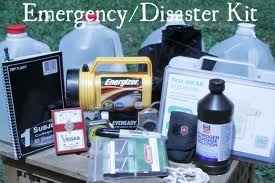
Fatigue
Increase in allergies, colds, or flu
Heart palpitations
Behaviour
Hyperactivity
Outbursts of anger or frequent arguments
Loss of objectivity
Withdrawal, social isolation, distancing yourself from others
Increased use of alcohol, tobacco, or other drugs
Avoidance of activities or places that remind you of the disaster
Family problems
If any of these symptoms affect your ability to function, seek medical attention from your doctor or a mental health provider familiar with the effects of
disasters. Some people may never have are action. Others may have delayed
reactions that can show up days, weeks, or even months after the disaster
happen. Not everyone has reactions right away. These symptoms may go and
then come back again when something makes you think about the disaster.
After a disaster, be sure to talk to someone about how you are feeling: a
member of the clergy, a counsellor, or someone in the Employee Assistance
Program provided by your employer. Also, the Red Cross has disaster mental
health professionals who can help you deal with the stress related to your
disaster experience.
Remember that service animals may also suffer emotional trauma. Get their
daily routine back to normal as soon as possible. This will make it easier for them to serve you as before.
Know how a disaster may affect your independence
You are used to being in a certain environment. However, a disaster can change your ability to deal with this environment. It is important that you anticipate for your lowest level of functioning for your personal disaster plan. Your condition may become worse because of physical or emotional reactions to stress. For
example, people who do not need the aid of devices on a daily basis may need a wheelchair after a disaster.
After a disaster, you may need to ask for help to do things you usually would
have done independently. Understandably, this may make you feel especially
vulnerable. You may need help putting your home back in order, filling out
forms, or providing documentation and information to disaster relief agencies.
This can add to the stress you may be feeling. A personal support network that knows your needs may anticipate some of them and make your recovery easier
and less stressful.
Know how to reduce the impact of a disaster on you
Now that you know what may happen, what can you do to reduce the effects of
the disaster and to develop a personal disaster plan?
Start by considering the following actions:
Creating a Personal Support Network
A personal support network (sometimes called a self-help team, but referred to only as a "network" in this booklet) can help you prepare for a disaster. They can do this by helping you identify and get the resources you need to cope
effectively with a disaster. Your network can help you practice vital activities, like evaluating your home or workplace. Network members can also assist you
after a disaster happens. You should put together your network before you assess what your
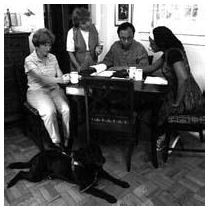
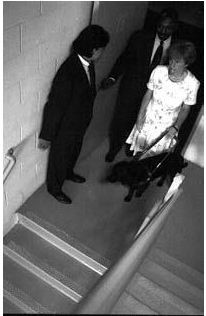
needs will be during and after a disaster. First
consider the ways to develop your personal
support network, and then go to Completing a
Personal Assessment for suggestions on how you
can prepare for a disaster.
Organize a network for your home, school,
workplace, volunteer site and any other place
where you spend a lot of time.
Organize a network for your home, school,
workplace, volunteer site, and any other place where you spend a lot of time.
Members of your network can be roommates, relatives, neighbours, friends, and
co-workers. They should be people you trust and who could check to see if you
need assistance. They should know your
capabilities and needs, and offer help within
minutes.
Do not depend on only one person. Include a
minimum of three people in your network for each
location where you regularly spend a lot of time
during the week.
Think of what your needs would be during a
disaster and discuss these with each of your
networks. Complete a written assessment of your
needs with your network in the space provided in
the following section. This can help your network
members learn the best ways to assist you and
offer additional ideas for you to think about.
Give your network members copies of your emergency information list, medical
information list, disability-related supplies and special equipment list,
evacuation plans, relevant emergency documents, and personal disaster plan
when you complete them.
Your network should know your capabilities and needs and offer help
within minutes.
Arrange with your network to check on you immediately if local officials give
an evacuation order or if a disaster occurs. Do this before an emergency
happens so that your network members can help you when you need them.
Also, ask your network to notify you of an emergency you may not know about.
For example, if a siren or loud speaker system notifies a neighbourhood of a
disaster and you are Deaf or have hearing loss, be sure that your network knows to give you this information. Ask them to give you any other disaster-related
information that is not already in writing, such as radio information about the disaster or the location of shelters.
Agree on how you and your network will contact each other during an
emergency. Do not count on the telephones working. Also, choose a signal for
help that you both understand. Signals can be shouting, knocking on the wall, or using a whistle, bell, or high-pitched noisemaker. Visual signals could include hanging a sheet outside your window.
Give the members of your network all the necessary keys they may need to get
into your home, car, etc.
Show your network how to operate and safely move the equipment you use for
your disability, if necessary. Ask them to "practice" with any of your special equipment. This will help them feel more comfortable when using it during an
emergency.
Make sure your service animal knows the people in your network. This will
make it easier for the animal to accept care from someone other than yourself.
Explain to your network any assistance for personal care that you may need.
Give them written instructions on how best to assist you and your animals.
Label your equipment and attach instruction cards on how to use and move each
item. Laminate the instruction cards for added durability.
Inform your network about any areas on your body where you have reduced
feeling. Have them check these areas for injuries after a disaster if you cannot check them yourself.
Practice your plan. Based on your knowledge of the disasters in your area,
simulate any problems or obstacles you may experience. Have the members of
your network practice how to help you, and familiarize them with any adaptive
equipment you may need.
Choose an emergency meeting place you are familiar with where you and others
can reunite after exiting a building. You should select a meeting place for each area where you spend a lot of time.
Select with your network a signal that you can use to let them know you are
okay and have left the site. Give your network your travel dates if you will be traveling.
Review and revise your personal assessment and disaster plan regularly, or as
your condition changes. Your network should help in this review as well. You
will also find that as you and your network practice, all of you will find
problems and solutions you have not thought of before.
The trusting relationship you develop with the members of your network should
be mutual. Learn about each other's needs and how to assist each other during
an emergency.
Completing a Personal Assessment
You should decide what you will be able to do for yourself and what assistance you may need before, during, and after a disaster. This will be based on the
environment after the disaster, your capabilities, and your limitations. To
complete a personal assessment, make a list of your personal needs and your
resources for meeting them in a disaster environment. Consider the following
information as you make your personal assessment.
Think about the following questions and note your answers in writing or record them on a tape cassette that you will share with your network. These answers
should describe both your physical capabilities right now and the assistance you will need during the time that the disaster disrupts your normal routine. Base your plan on your lowest anticipated level of functioning.
Daily Living
Personal Care
Do you need assistance with personal care, such as bathing and grooming? Do
you use adaptive equipment to help you get dressed?
My Capabilities Today:
Assistance I Need Because of Disaster:
Water Service
What will you do if water service is cut off for several days, or if you are unable to heat water?
My Capabilities Today:
Assistance I Need Because of Disaster:
Personal Care Equipment
Do you use a shower chair, tub-transfer bench, or other similar equipment?
My Capabilities Today:
Assistance I Need Because of Disaster:
Adaptive Feeding Devices
Do you use special utensils that help you prepare or eat food independently?
My Capabilities Today:
Assistance I Need Because of Disaster:
Electricity-Dependent Equipment
How will you continue to use equipment that runs on electricity, such as
dialysis, electrical lifts, etc.?
My Capabilities Today:
Assistance I Need Because of Disaster:
Getting Around
Disaster Debris
How will you cope with the debris in your home following the disaster?
My Capabilities Today:
Assistance I Need Because of Disaster:
Transportation
Do you need a specially-equipped vehicle or accessible transportation?
My Capabilities Today:
Assistance I Need Because of Disaster:
Errands
Do you need to get groceries, medications, and medical supplies? Think about
what you will do if you depend on only one person to shop or run errands for
you. What if your assistant cannot reach you because roads are blocked or
because the disaster has affected him or her as well?
My Capabilities Today:
Assistance I Need Because of Disaster:
Evacuating
Building Evacuation
Do you need help to leave your home or office?
My Capabilities Today:
Assistance I Need Because of Disaster:
Building Exits
If the elevator is not working or cannot be used, are there other exits? (Include using a window as an alternate escape.)
My Capabilities Today:
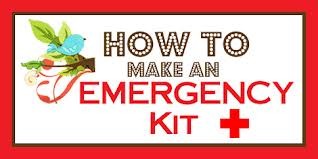
Assistance I Need Because of Disaster:
Getting Help
How will you call for the help you will need to leave the building?
My Capabilities Today:
Assistance I Need Because of Disaster:
Mobility Aids
What will you do if you cannot find your mobility aids, or cannot find or use
equipment necessary for your service animal?
My Capabilities Today:
Assistance I Need Because of Disaster:
Ramp Access
What will you do if your ramps are shaken loose or become separated from the building?
My Capabilities Today:
Assistance I Need Because of Disaster:
Service Animals/Pets
Will you be able to care for your animal (provide food, shelter, veterinary
attention, etc.) during and after a disaster? Do you have another caregiver for your animal if you are unable to meet its needs?
My Capabilities Today:
Assistance I Need Because of Disaster:
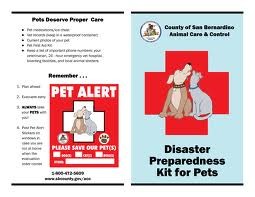
Personal Disaster Preparation
How well you prepare and how much you practice before a disaster occurs will
determine how successfully you deal with and recover from disasters. Your
personal disaster preparation is a continuing process. It helps you and your
network identify, get, develop, manage, and maintain the information and
resources you will need to deal with a disaster when it happens.
Prepare yourself based on the capabilities and limitations you believe you will have after the disaster. Also keep in mind that your usual ways of support and assistance may not be available to you for some time during an evacuation and
after the disaster has occurred.
Make a personal disaster plan. This will help you organize information you will need and activities you will do during and after a disaster. Key items in a
personal disaster plan are described below. Keep copies of your disaster plan in your disaster supplies kit, car, wallet (behind driver's license or primary
identification card), and wheelchair pack or at work, etc; also, share your
disaster plan with your network.















